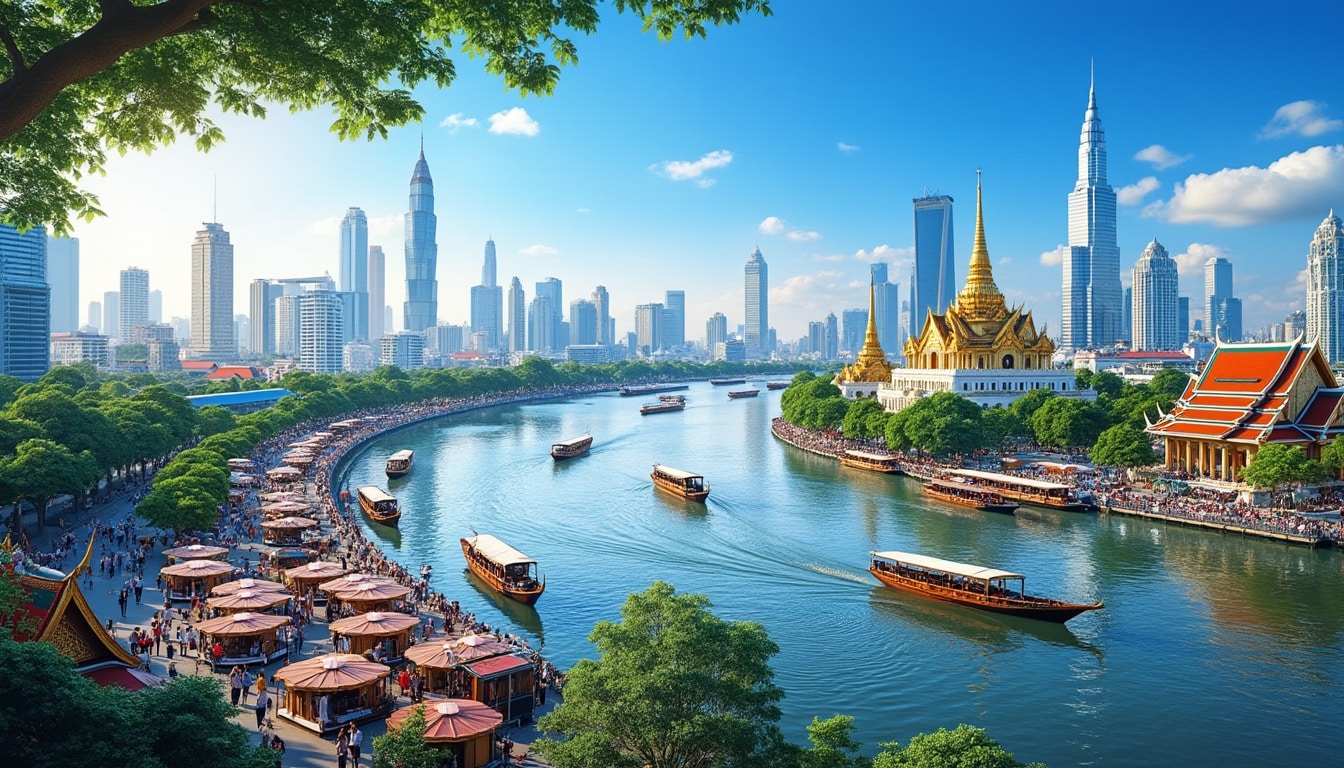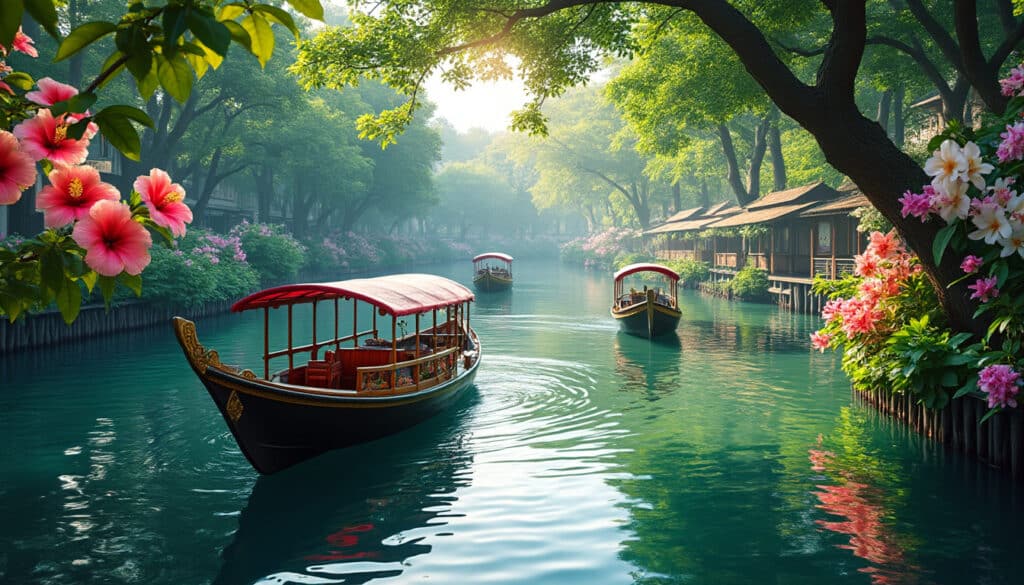Bangkok, often dubbed “The Big Mango,” is a bustling metropolis that fascinates visitors with its blend of tradition and modernity. Situated in the heart of Thailand, this city is home to a rich history, stunning cultural sites, and vibrant local life. Nestled on the low-lying delta of the Chao Phraya River, Bangkok is much more than a chaotic urban center; it’s a geographical marvel. With features ranging from its intricate network of canals to the spacious urban green parks, Bangkok is ripe for exploration. For anyone ready to dive into its heart, thus begins an adventure through the geographical tapestry of this fascinating city.
Exploring Bangkok’s River: The Lifeblood of the City
The Chao Phraya River meanders through Bangkok, playing an integral role in the life and history of the city. Known to locals as the “River of Kings,” this waterway is the main artery around which the city developed. It runs southwards through the central plains, ultimately emptying into the Gulf of Thailand, approximately 25 kilometers from the city center. The river’s presence has had a significant influence on Bangkok’s layout and economy, fostering trade and transportation.
Bangkok River Tours and Chao Phraya Cruises offer visitors an enchanting way to see the city from a different angle. While cruising along the river, passengers can witness a juxtaposition of traditional wooden houses standing alongside modern high-rise buildings. The riverbanks are dotted with numerous historical landmarks, particularly the Grand Palace and the majestic Wat Arun, offering beautiful vistas that are rich in cultural significance.
Historically, the Chao Phraya played a crucial role in the development of Bangkok. During the Ayutthaya Kingdom, it served as a key trading route, attracting merchants from across Asia. The river facilitated the transport of goods and people, contributing significantly to the economic and cultural growth of the city. As a result, Bangkok became a thriving trading hub in Southeast Asia by the 18th century. The river’s influence extends to modern times, and while land-based transportation has largely taken over, the importance of the Chao Phraya in the urban narrative of Bangkok remains.
To ensure sustainable use of the river, Bangkok authorities have undertaken initiatives to monitor water quality, manage pollution, and support flood prevention. Given Bangkok’s low elevation and susceptibility to flooding, especially during the monsoon season, these efforts are critical. Indeed, the Chao Phraya is not just a geographical feature; it’s a living entity that embodies the rhythm and pulse of Bangkok.
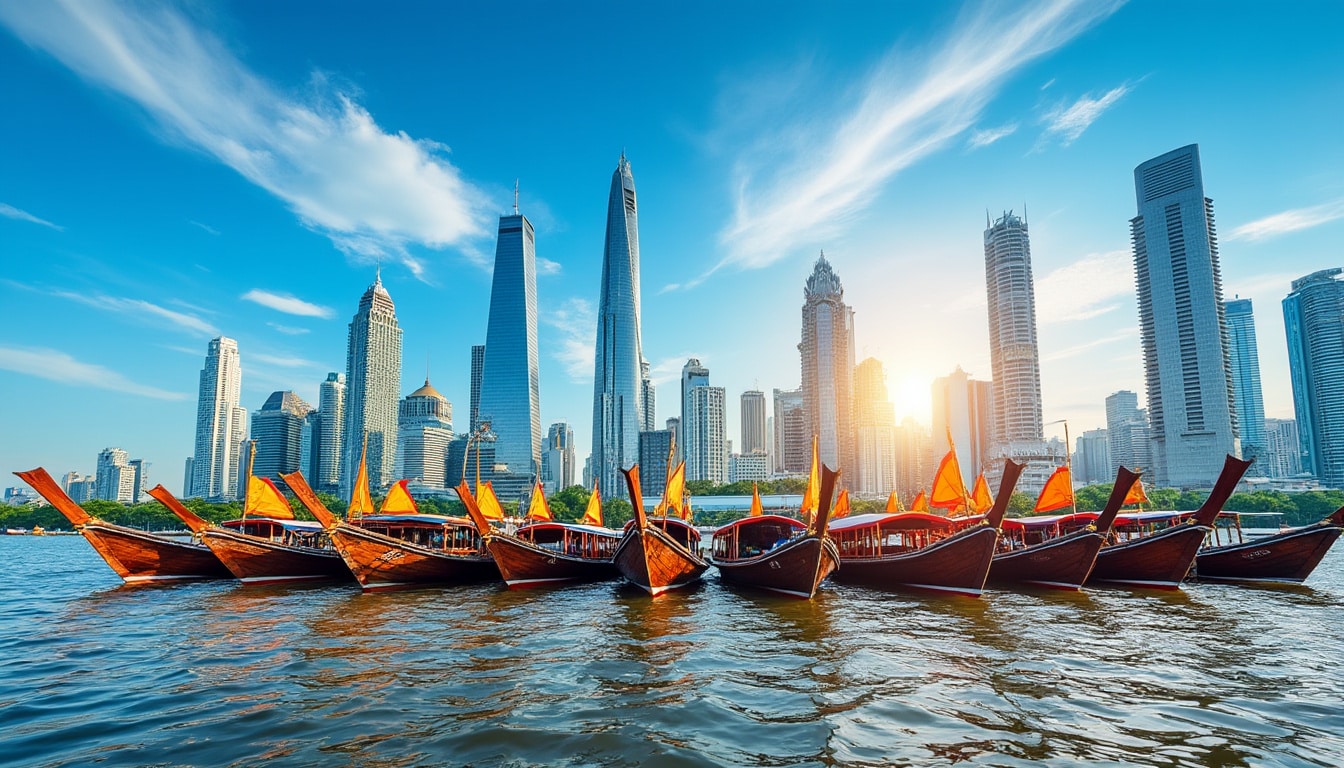
The River’s Ecological Impact
While the river provides economic benefits, it is also home to diverse ecosystems. The banks of the Chao Phraya host various species of birds, reptiles, and fish, some of which are native to Thailand. It plays a vital role in maintaining the biodiversity of the region. Ecological conservation activities include preserving riverain flora and fauna, which have become increasingly necessary to balance urbanization and environmental sustainability.
Bangkok’s intricate relationship with the Chao Phraya River demonstrates how geography can shape the economy, culture, and lifestyle of a city, adding a unique depth to Bangkok’s identity as the heart of Thailand.
Imagining the Cityscape: Bangkok’s Skyscrapers and Urban Planning
Bangkok’s skyline is a testament to its rapid urbanization and economic dynamism. The cityscape reveals a mix of traditional and cutting-edge architecture. Bangkok’s skyscrapers rank among the top in Southeast Asia, offering a striking contrast to the city’s ancient temples. The Bangkok Sky Bar is situated on the top floors of one of these towering buildings, providing a panoramic view of the vibrant city lights against the stark silhouette of high-rise structures.
Urban planning in Bangkok is a fascinating interplay between modern developments and historical preservation. This city does not have a single centralized business district, but rather a few key areas where distinctive commercial activities flourish. For instance, Sukhumvit Suites is a renowned residential and commercial hub, blending contemporary living spaces with bustling shopping and dining venues.
One noteworthy aspect of Bangkok’s urban planning is its network of elevated expressways and railways designed to address the city’s persistent traffic problems. The Bangkok Mass Transit System (BTS), colloquially known as the Skytrain, offers an efficient way to navigate the city beyond the often-congested streets below. It connects various parts of Bangkok, alleviating daily traffic woes for residents and visitors alike.
Despite the city’s rapid urban sprawl, spaces like Lumphini Park offer necessary green zones that provide residents and tourists a respite from the hectic urban environment. These green oases are invaluable for maintaining quality of life, supporting biodiversity, and promoting outdoor recreation in an otherwise concrete-heavy landscape.
Historic and Cultural Integration
The city’s topography has inspired developers to integrate traditional Thai elements into new constructions, honoring the capital’s rich heritage. The juxtaposition between old and new is seen in urban districts such as Rattanakosin Island, where iconic landmarks like the Grand Palace and Wat Pho coexist with modern infrastructure. Organizations and city planners are consistently working to balance the preservation of Bangkok’s cultural sites with the pressing demand for urban development, ensuring that the city’s growth does not come at the expense of its historical gems.
In summary, Bangkok’s cityscape is a complex matrix of high-rises and sacred sites, reflecting its ability to blend longstanding cultural sensitivity with economic development. It is a city that continuously evolves while maintaining its historical narrative.
Navigating Bangkok’s Flood Risks and Climate Considerations
Due to its geographical location on the Chao Phraya delta, Bangkok is susceptible to flooding, particularly during the rainy season spanning from May to October. It’s no wonder that city planners have dedicated considerable resources towards developing comprehensive flood management systems, which include drainage tunnels, flood barriers, and pumping stations.
Historically, Bangkok relied heavily on a complex network of canals for transportation and water management, earning it the nickname “Venice of the East.” Though many canals have been filled in to make way for roads and urban expansions, several still function as vital components of the city’s drainage system.
Climate-wise, Bangkok experiences a tropical monsoon climate, with distinct wet and dry seasons. The months from November to February are considered the best time to visit, offering cooler and drier weather. However, environmental experts are increasingly focused on the effects of climate change on the city. Extreme weather patterns threaten to exacerbate flooding risks, prompting initiatives to incorporate climate adaptation measures in urban planning.
Innovative Flood Management Techniques
Bangkok’s approach to flood management includes the development of large-scale projects such as the “Monkey Cheek” water retention system. This innovative design allows for the temporary storage of rainwater in retention areas, which is then redirected through canals into the river. Such sustainable approaches aim to enhance the city’s resilience against heavy downpours and the likelihood of floods.
The city is also adopting green infrastructure as an integral component of its flood response strategy. Integrating green zones like parks that double as water catchment areas helps absorb excess rainfall effectively. Lumphini Park Adventures, for instance, emphasizes eco-friendly initiatives to not only offer recreation but also contribute positively to the city’s flood mitigation strategies.
Through these efforts, Bangkok is making strides in becoming a more resilient city, showcasing proactive approaches to tackling its geographical and climate-related challenges.
Biodiversity and the Role of Green Spaces in Bangkok
Amidst Bangkok’s urban sprawl, green spaces play a crucial role in nurturing biodiversity and improving environmental quality. These oases not only offer residents a breath of fresh air but also serve as hotspots for diverse flora and fauna. Parks, gardens, and undeveloped areas collectively contribute to the city’s ecological health.
The vast expanse of Chatuchak Market may be famous for shopping, but its proximity to Chatuchak Park highlights how commercial and natural spaces can coexist harmoniously. This neighborhood becomes a weekend attraction not just for bargain hunters but also for those seeking refuge in green areas.
Besides urban parks, Bangkok’s biodiversity is further enriched by initiatives like the Bangkok Floating Market, where traditional produce cultivation and native plant species thrive. These local markets serve as reminders of the region’s agricultural heritage while supporting Bangkok’s ecological balance.
In addition to offering recreational spaces, these parks and markets help reduce urban heat and improve air quality. Studies suggest that urban green spaces significantly mitigate the urban heat island effect, which is especially crucial for bustling cities like Bangkok.
The Intersection of Commerce and Ecology
Green initiatives extend beyond parks, with commercial centers like Sukhumvit Suites adopting green architecture. Skills in traditional farming practices are being reinvigorated through programs encouraging commercial-residential spaces to incorporate rooftop gardens and urban farms. Not only do these improvements enhance the aesthetic value of buildings, but they also contribute hugely to the city’s air quality, intersecting commerce with environmental conservation.
Ultimately, Bangkok is demonstrating that even in a densely populated metropolis, a commitment to maintaining and expanding green spaces can contribute significantly to a healthier environment and improve quality of life for all residents.
The Influence of Geography on Bangkok’s Cultural Tapestry
Bangkok’s rich cultural tapestry is woven deeply into its geographical contradictions. From the bustling modernity of Sukhumvit to the ancient temples of Ayutthaya and the vibrant backpacker scene of Khao San Road, Bangkok’s unique cultural identity is reflected in its varied geography. Known for its warmth and hospitality, the city extends an unliving canvas celebrating traditional crafts, street food, and vibrant street life.
One of Bangkok’s prominent cultural offerings is the Grand Palace Experiences. As an iconic landmark, it represents Thailand’s architectural mastery and royal heritage. Accompanied by renowned Bangkok River Tours, these experiences allow tourists to dive deep into the nation’s illustrious past. You can learn more about Bangkok’s history and its rich cultural influences through this detailed timeline.
Meanwhile, the city’s markets like the Chatuchak Market serve as melting pots of culture, attracting both locals and tourists to its myriad of stalls offering everything from authentic Thai street food to traditional crafts and antiques. In this urban interplay, the influence of Bangkok’s geography is undeniable as it shapes the city’s cultural expressions.
Connecting Tradition with Modernity
Rivers and canals often act as conduits for cultural activities, allowing events such as the annual Loy Krathong festival to flourish. Here, the city’s waterways become illuminated with floating lanterns, becoming the backdrop for a month-long celebration steeped in tradition. Additionally, Khao San Road Backpackers thrive on accessing these rich cultural narratives, forming vibrant exchanges of stories and experiences around Bangkok’s many attractions.
This synthesis represents a unique aspect of Bangkok, where the geographical landscape is as much a stage for cultural celebration as it is a stage for daily life. From lively streets to serene temples, geography is at the heart of Bangkok’s identity, intertwining with its thriving cultural traditions.
| Feature | Impact on Bangkok |
|---|---|
| Chao Phraya River | Facilitates trade and transportation, vital for economic development |
| Urban Skyline | Symbol of modernization and economic growth |
| Flood Management | Essential for mitigating seasonal flooding risks |
| Green Spaces | Promote biodiversity and enhance residents’ quality of life |
| Cultural Sites | Highlight Bangkok’s rich history and attract tourism |
FAQ
- What is a significant geographical feature of Bangkok?
- How does Bangkok manage its flood risks?
- What are some ways to explore Bangkok’s culture?
- What role do green spaces play in Bangkok?
- How has geography influenced Bangkok’s development?
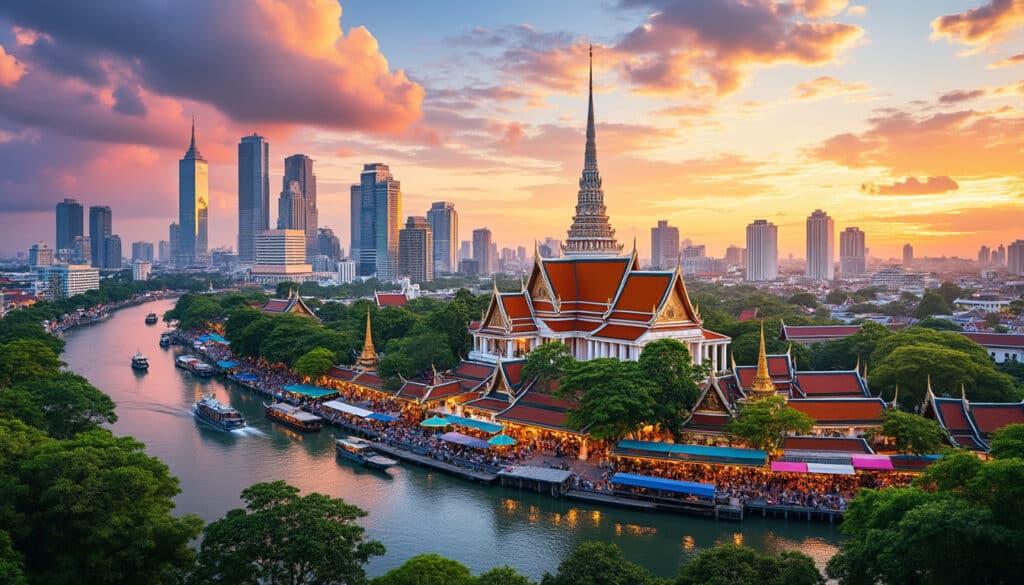
Nature and Geography of Bangkok
Bangkok, the dynamic capital of Thailand, is renowned for its energetic streets, fascinating culture, and thriving urban life. But behind its modern façade lies an unexpected world of natural beauty and geographical intrigue. From lush green parks within the bustling…

Location and coordinates of Bangkok
Bangkok, a city pulsating with life, is not just the capital of Thailand but also a dynamic crossroad of culture, history, and innovation. Located in Southeast Asia, this city is a melting pot where traditional temples blend with modern skyscrapers.…
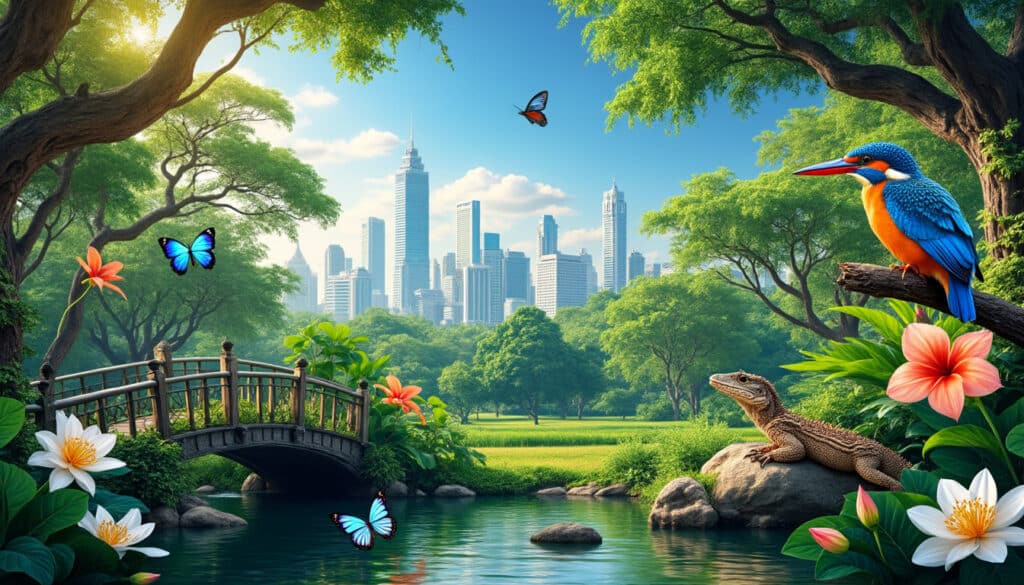
Nature and wildlife in Bangkok
Bangkok, known for its vibrant culture, bustling markets, and dynamic cityscape, offers more than meets the eye. Beneath the urban hustle lies a treasure of natural beauty and wildlife waiting to be discovered by both tourists and locals alike. Whether…

